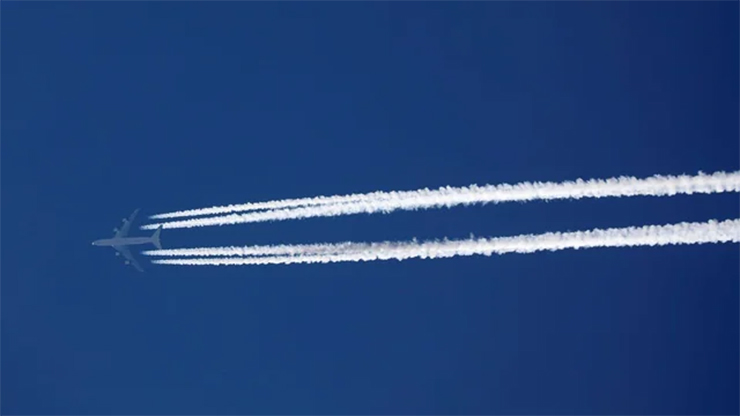
New Delhi: To fight global warming, scientists believe that with the reduction of contrails—condensation trails—of ice crystals that form artificial clouds around particles in the planes’ exhaust and are left behind by airliners, global warming can be slowed.
With emissions from airplanes responsible for about 3.5% of human-caused global warming, Aviation is a significant contributor to climate change. The clouds trap formed due to condensation trails heat in the Earth’s atmosphere. According to researchers at Breakthrough Energy and Google reducing contrails can help in solving the global warming, though partially.
The head of contrails at Breakthrough Energy, Marc Shapiro calls reducing contrails the “highest-leverage climate opportunity that we know of,” the equivalent of removing carbon from the atmosphere at a cost of 10 dollars per ton or less.
Last year, the Intergovernmental Panel on Climate Change (IPCC) estimated that contrails represent about 35% of the aviation industry’s contribution to global warming. The science of contrail control began in the 1940s, with efforts to build stealthier military aircraft, but by the 1990s scientists had realised that cirrus clouds play a heating role in the atmosphere—and cirrus clouds are similar to (and indeed can be seeded by) aircraft contrails. But with know-how from satellite observation, greased by machine learning, airlines can fly their aircraft to avoid creating contrails. The key is avoiding humid “ice supersaturated regions” of the atmosphere where long-lasting contrails can form. Typically, this requires changes in altitude similar to those pilots already perform to avoid regions of turbulence.
Founded by Bill Gates, Breakthrough Energy is an organisation to pursue climate solutions. Google’s Research division having separately developed models to predict where contrails will form, began collaborating to develop one solution in 2022. Juliet Rothenburg, who leads Google’s work at the intersection of climate change and “artificial intelligence” explained, “Relative humidity predictions are notoriously inaccurate.”
Using data from NASA’s GOES-16 weather satellite, along with other weather indicators in their approach, the developers had to train machine-learning software to recognise contrails in their data set, and then train it to predict where contrail-conducive regions would occur in the future.
American Airlines was brought in to test the product in the wild by the two organisations. The predictions were integrated into the pilots’ flight planning software, and over the course of 70 flights between January and March of 2023, pilots would fly both modified and standard routes to create useful comparisons. By examining satellite data after the flights took place, the researchers were able to conclude that their software reduced contrail creation by 54%.
“All airlines are going to have to do this eventually—[in] years, not decades,” Jill Blickstein, American’s VP of sustainability says. Still, there are wrinkles to iron out. Notably, the additional manoeuvring increased American’s fuel usage by about 2%, which Blickstein calls a “meaningful number. We don’t take additional expense lightly.” Beyond buying more fuel, it’s important to make sure the climate benefits of avoiding contrails also outweigh the additional emissions.
The three organisations are planning to expand these experiments and involve other airlines and air traffic control organisations, in particular with night flights in low-density airspace, like transatlantic routes (Night time contrails have a much bigger warming effect). While deploying this technology across airlines is fairly straightforward—it’s another “weather data layer” to add to existing flight planning software, Shapiro says—the impact of those new manoeuvres on air traffic would need to be reckoned with. Plans to use satellite data to optimise flight paths to burn less fuel, for example, have run into challenges coordinating with air traffic controllers.
How this service will be deployed commercially is not yet clear. Google and Breakthrough view it as research underlying their commitments to reducing carbon footprints. According to Blickstein, American is pleased to contribute to this research, but that any reduction in climate impact wouldn’t affect the airline’s pledge to reach net zero emissions by 2050 because the data is not granular enough to precisely calculate a single airline’s contrail contributions. Rothenburg opines that higher resolution satellites being launched in the years ahead could change that.
Hoping to develop an independent organisation that can collect this contrail data and provide verification, Breakthrough’s vision is that the organisation becomes an airline-supported clearinghouse for this data, like the International Airline Trade Association, a venue for global coordination in the air travel business. Still, “we can do a lot with a coarse estimate,” Blickstein says. The potential is there to reduce about 1% of human contribution to global warming, if we can just fly the planes in the right places.















